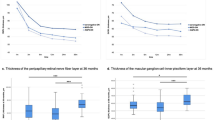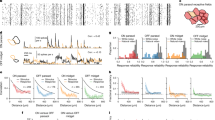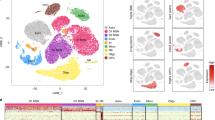Abstract
A layered organization of cells is a common architectural feature of many neuronal formations. Mutations of the zebrafish gene nagie oko (nok) produce a severe disruption of retinal architecture, indicating a key role for this locus in neuronal patterning. We show that nok encodes a membrane-associated guanylate kinase-family scaffolding protein. Nok localizes to the vicinity of junctional complexes in retinal neuroepithelium and in the photoreceptor cell layer. Mosaic analysis indicates that the nok retinal patterning phenotype is not cell-autonomous. We propose that nok function in patterning of postmitotic neurons is mediated through neuroepithelial cells and is necessary for guiding neurons to their proper destinations in retinal laminae.
This is a preview of subscription content, access via your institution
Access options
Subscribe to this journal
Receive 12 print issues and online access
$259.00 per year
only $21.58 per issue
Buy this article
- Purchase on SpringerLink
- Instant access to full article PDF
Prices may be subject to local taxes which are calculated during checkout





Similar content being viewed by others
References
Feng, Y. et al. LIS1 regulates CNS lamination by interacting with mNudE, a central component of the centrosome. Neuron 28, 665–679 (2000).
Matsunaga, M., Hatta, K. & Takeichi, M. Role of N-cadherin cell adhesion molecules in the histogenesis of neural retina. Neuron 1, 289–295 (1988).
Tomita, K. et al. Mammalian hairy and enhancer of split homolog 1 regulates differentiation of retinal neurons and is essential for eye morphogenesis. Neuron 16, 723–734 (1996).
Tomasiewicz, H. et al. Genetic deletion of a neural cell adhesion molecule variant (N-CAM-180) produces distinct defects in the central nervous system. Neuron 11, 1163–1174 (1993).
Stumpo, D., Bock, C., Tuttle, J. & Blackshear, P. MARCKS deficiency in mice leads to abnormal brain development and perinatal death. Proc. Natl Acad. Sci. USA 92, 944–948 (1995).
Georges-Labouesse, E., Mark, M., Messaddeq, N. & Gansmuller, A. Essential role of a6 integrins in cortical and retinal lamination. Curr. Biol. 8, 983–986 (1998).
Dyer, M.A. & Cepko, C.L. p27Kip1 and p57Kip2 regulate proliferation in distinct retinal progenitor cell populations. J. Neurosci. 21, 4259–4271 (2001).
Pujic, Z. & Malicki, J. Mutation of the zebrafish glass onion locus causes early cell-nonautonomous loss of neuroepithelial integrity followed by severe neuronal patterning defects in the retina. Dev. Biol. 234, 454–469 (2001).
Malicki, J. & Driever, W. oko meduzy mutations affect neuronal patterning in the zebrafish retina and reveal cell-cell interactions of the retinal neuroepithelial sheet. Development 126, 1235–1246 (1999).
Jensen, A.M., Walker, C. & Westerfield, M. mosaic eyes: a zebrafish gene required in pigmented epithelium for apical localization of retinal cell division and lamination. Development 128, 95–105 (2001).
Malicki, J. et al. Mutations affecting development of the zebrafish retina. Development 123, 263–273 (1996).
Dimitratos, S.D., Woods, D.F., Stathakis, D.G. & Bryant, P.J. Signaling pathways are focused at specialized regions of the plasma membrane by scaffolding proteins of the MAGUK family. Bioessays 21, 912–921 (1999).
Woods, D. & Bryant, P. The disc-large tumor suppressor gene of Drosophila encodes a guanylate kinase homolog localized at septate junctions. Cell 66, 451–464 (1991).
Ohshiro, T., Yagami, T., Zhang, C. & Matsuzaki, F. Role of cortical tumour-suppressor proteins in asymmetric division of Drosophila neuroblast. Nature 408, 593–596 (2000).
Peng, C.Y., Manning, L., Albertson, R. & Doe, C.Q. The tumour-suppressor genes lgl and dlg regulate basal protein targeting in Drosophila neuroblasts. Nature 408, 596–600 (2000).
Lahey, T., Gorczyca, M., Jia, X.X. & Budnik, V. The Drosophila tumor suppressor gene dlg is required for normal synaptic bouton structure. Neuron 13, 823–835 (1994).
Marfatia, S.M., Morais-Cabral, J.H., Kim, A.C., Byron, O. & Chishti, A.H. The PDZ domain of human erythrocyte p55 mediates its binding to the cytoplasmic carboxyl terminus of glycophorin C. Analysis of the binding interface by in vitro mutagenesis. J. Biol. Chem. 272, 24191–24197 (1997).
Hsueh, Y.P., Wang, T.F., Yang, F.C. & Sheng, M. Nuclear translocation and transcription regulation by the membrane- associated guanylate kinase CASK/LIN-2. Nature 404, 298–302 (2000).
Hinds, J. & Hinds, P. Early ganglion cell differentiation in the mouse retina: an electron microscopic analysis utilizing serial sections. Dev. Biol. 37, 381–416 (1974).
Chenn, A., Zhang, Y.A., Chang, B.T. & McConnell, S.K. Intrinsic polarity of mammalian neuroepithelial cells. Mol. Cell. Neurosci. 11, 183–193 (1998).
Kamberov, E. et al. Molecular cloning and characterization of Pals, proteins associated with mLin-7. J. Biol. Chem. 275, 11425–11431 (2000).
Bachmann, A., Schneider, M., Theilenberg, E., Grawe, F. & Knust, E. Drosophila Stardust is a partner of Crumbs in the control of epithelial cell polarity. Nature 414, 638–643 (2001).
Hong, Y., Stronach, B., Perrimon, N., Jan, L.Y. & Jan, Y.N. Drosophila Stardust interacts with Crumbs to control polarity of epithelia but not neuroblasts. Nature 414, 634–638 (2001).
Kim, E. et al. GKAP, a novel synaptic protein that interacts with the guanylate kinase-like domain of the PSD-95/SAP90 family of channel clustering molecules. J. Cell. Biol. 136, 669–678 (1997).
Nix, S.L., Chishti, A.H., Anderson, J.M. & Walther, Z. hCASK and hDlg associate in epithelia, and their src homology 3 and guanylate kinase domains participate in both intramolecular and intermolecular interactions. J. Biol. Chem. 275, 41192–41200 (2000).
Nasevicius, A. & Ekker, S.C. Effective targeted gene 'knockdown' in zebrafish. Nature Genet. 26, 216–220 (2000).
Dowling, J. The Retina (Harvard University Press, Cambridge, Massachusetts, 1987).
Nakayama, K. et al. Mice lacking p27(Kip1) display increased body size, multiple organ hyperplasia, retinal dysplasia, and pituitary tumors. Cell 85, 707–720 (1996).
Hinds, J. & Hinds, P. Differentiation of photoreceptors and horizontal cells in the embryonic mouse retina: an electron microscopic, serial section analysis. J. Comp. Neur. 187, 495–512 (1979).
Ho, R.K. & Kane, D.A. Cell-autonomous action of zebrafish spt-1 mutation in specific mesodermal precursors. Nature 348, 728–730 (1990).
Westerfield, M. The Zebrafish Book (University of Oregon Press, Eugene, 2000).
Hu, M. & Easter, S.S. Retinal neurogenesis: the formation of the initial central patch of postmitotic cells. Dev. Biol. 207, 309–321 (1999).
Fujisawa, H. A complete reconstruction of the neural retina of chick embryo grafted onto the chorio-allantoic membrane. Dev. Growth Differ. 13, 25–36 (1971).
Sheffield, J. & Moscona, A. Electron microscopic analysis of aggregation of embryonic cells: the structure and differentiation of aggregates of neural retina cells. Dev. Biol. 23, 36–61 (1970).
Bilder, D., Li, M. & Perrimon, N. Cooperative regulation of cell polarity and growth by Drosophila tumor suppressors. Science 289, 113–116 (2000).
Kaech, S.M., Whitfield, C.W. & Kim, S.K. The LIN-2/LIN-7/LIN-10 complex mediates basolateral membrane localization of the C. elegans EGF receptor LET-23 in vulval epithelial cells. Cell 94, 761–771 (1998).
Muller, H.A. Genetic control of epithelial cell polarity: lessons from Drosophila. Dev. Dyn. 218, 52–67 (2000).
Streisinger, G., Singer, F., Walker, C., Knauber, D. & Dower, N. Segregation analyses and gene-centromere distances in zebrafish. Genetics 112, 311–319 (1986).
Knapik, E.W. et al. A microsatellite genetic linkage map for zebrafish (Danio rerio). Nature Genet. 18, 338–343 (1998).
Knapik, E.W. et al. A reference cross DNA panel for zebrafish (Danio rerio) anchored with simple sequence length polymorphisms. Development 123, 451–460 (1996).
Tang, T.L., Freeman Jr, R.M., O'Reilly, A.M., Neel, B.G. & Sokol, S.Y. The SH2-containing protein-tyrosine phosphatase SH-PTP2 is required upstream of MAP kinase for early Xenopus development. Cell 80, 473–483 (1995).
Malicki, J. Development of the retina. Methods Cell Biol. 59, 273–299 (1999).
Acknowledgements
The authors are indebted to T. Dryja, L. Zon, S. Heller, B. Sewell, J. Shen, Z. Pujic and H. Jo for comments on earlier versions of this manuscript. We thank Z. Pujic, G. Doerre, T. Li, D. Hong, C. Lu, L. Zon, B. Barut, D. Ransom, N. Trede and D. Sgroi for technical assistance. This work was supported by awards from the Knights Templar Eye Foundation (to X.W.), the March of Dimes Birth Defects Foundation (to J.M.), the Research to Prevent Blindness Foundation (to J.M.) and the National Eye Institute (to J.M.).
Author information
Authors and Affiliations
Corresponding author
Ethics declarations
Competing interests
The authors declare no competing financial interests.
Supplementary information
Rights and permissions
About this article
Cite this article
Wei, X., Malicki, J. nagie oko, encoding a MAGUK-family protein, is essential for cellular patterning of the retina. Nat Genet 31, 150–157 (2002). https://doi.org/10.1038/ng883
Received:
Accepted:
Published:
Issue date:
DOI: https://doi.org/10.1038/ng883
This article is cited by
-
Development of brain ventricular system
Cellular and Molecular Life Sciences (2018)
-
Cellular Expression of Smarca4 (Brg1)-regulated Genes in Zebrafish Retinas
BMC Developmental Biology (2011)
-
Mechanisms of cell polarity and aquaporin sorting in the nephron
Pflügers Archiv - European Journal of Physiology (2011)
-
Tissue-specific requirements for specific domains in the FERM protein Moe/Epb4.1l5 during early zebrafish development
BMC Developmental Biology (2008)
-
Genetic control of single lumen formation in the zebrafish gut
Nature Cell Biology (2007)



